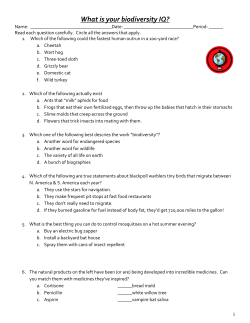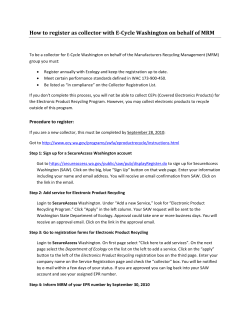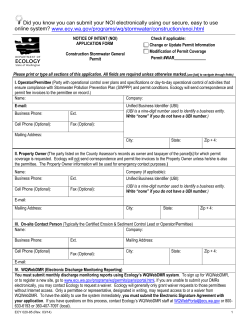
Earth Jeopardy
Earth Jeopardy Basic Basic Food BIOMES Ecology A Ecology B Chains/Webs Population Biodiversity Ecology Q $100 Q $100 Q $100 Q $100 Q $100 Q $100 Q $200 Q $200 Q $200 Q $200 Q $200 Q $200 Q $300 Q $300 Q $300 Q $300 Q $300 Q $300 Q $400 Q $400 Q $400 Q $400 Q $400 Q $400 Q $500 Q $500 Q $500 Q $500 Q $500 Q $600 Q $500 Q $600 Q $600 Final Jeopardy Q $600 $100 Basic Ecology Study of the relationships between organisms and their environment $100 Answer from Ecology What is Ecology? $200 Basic Ecology Sunlight Temperature Moisture Nutrients are all ____________ components of an ecosystem $200 Answer from Water Cycle What are abiotic factors? $300 Basic Ecology Groups of organism that resemble each other in appearance, behavior, chemistry and genetics, and can produce fertile offspring $300 Answer from Basic Ecology What is a Species? $400 Basic Ecology COMMUNITY OF DIFFERENT SPECIES INTERACTING WITH EACH OTHER AND THEIR NON-LIVING ENVIRONMENT OF MATTER AND ENERGY. $400 answer Basic Ecology What is an ecosystem? $500 Question Basic Ecology Group of interacting individuals of same species, in a specific area and specific time. $500 Answer Basic Ecology What is a Population? $600 Question Basic Ecology Elimination of this species type can have drastic effects on a community (reduction in diversity) $600 answer Basic Ecology What is a keystone species? $100 Basic Ecology B Place where a population or an organism lives $100 Answer Basic Ecology B What is a habitat? $200 Question Basic Ecology B complex interacting network of plants, animals, and microorganisms $200 Answer Basic Ecology B What is a community? $300 Question Basic Ecology B describes what an organism does and how it interacts with the biotic and abiotic factors in the environment. $300 Answer Basic Ecology B What is a niche? $400 Question Basic Ecology B A species that is more sensitive to environmental degradation and can serve as an early warning $400 Answer Basic Ecology B What is an indicator species? $500 Question Basic Ecology B Species that migrate into an ecosystem or are deliberately or accidentally introduced into an ecosystem by humans. $500 Answer Basic Ecology What is a non-native species? $600 Question Basic Ecology B 1. Supplies energy for photosynthesis 2. Powers the cycling of matter. 3. Drives the climate and weather systems $600 Answer Basic Ecology B What is the sun? $100 Question Food Chains/Webs make their own food from compounds obtained from environment. $100 Answer from Food Chains/Webs What is a producer? $200 Question from Food Chains/Webs ability of producer to convert sunlight, abiotic nutrients to sugars and other complex organic compounds $200 Answer from Food Chains/Webs What is photosynthesis? $300 Question from Food Chains/Webs Bacteria can convert simple compounds from their environment into more complex nutrient compound without sunlight $300 Answer from Food Chains/Webs What is Chemosynthesis? $400 Question from Food Chains/Webs Obtain energy and nutrients by feeding on other organisms $400 Answer from Food Chains/Webs What are Consumers? $500 Question from Food Chains/Webs These two consumer types live off of detritus ( types of detritivores) $500 Answer from Food Chains/Webs What are detritus feeders and decomposers? $600 Question from Food Chains/Webs The loss of this at each trophic level is why energy flow pyramids rarely have more than 4 levels $600 Answer from Food Chains/Webs What is heat energy? $100 Question from BIOMES What biome? • cold, vast, treeless area of low, swampy plains • Most of Greenland • Coldest biome • Contains permafrost $100 Answer from BIOMES What is the tundra? $200 Question BIOMES • Major regions are found in eastern North America, Europe, and eastern Asia • deciduous • 4 seasons $200 Answer BIOMES What is temperate? $300 Question BIOMES • one-fifth of the earth's land surface • Great Basin, the Mojave, the Sonoran, and the Chihuahuan • Cold at night, hot in daytime $300 Answer from BIOMES What is a desert? $400 Question BIOMES • hot, dry climates that are perfect for growing food ..• receives so little rain that very few trees can grow $400 Answer BIOMES What is grassland? $500 Question BIOMES • • • • Largest forests on earth Found below the tundra Trees mostly conifers Soil is wet, thick, spongy $500 Answer BIOMES What is Taiga? $100 Question Population Ecology The number of individuals that can be sustained in a given space $100 Answer Population Ecology What is Carrying capacity? $200 Question Population Ecology the number of individuals in a population at a given time $200 Answer Population Ecology What is population size? $300 Question Population Ecology Besides food, a biotic factor that could cause a population to increase $300 Answer Population Ecology Multiple answers $400 Question Population Ecology Abiotic factor that might cause a population to migrate closer to the north pole $400 Answer Population Ecology What is temperature increase? $500 Question Population Ecology When resources are unlimited a population might exhibit this type of growth $500 answer Population Ecology What is exponential growth? $100 Question Biodiversity Essential to the quality of human life and to the functioning of the world’s economies $$$$$ $100 Biodiversity Answer What is biodiversity? $200 Question Biodiversity A service of biodiversity - provides renewable and nonrenewable _________ $200 Answer Biodiversity resources $300 Question Biodiversity Biodiversity helps recycle these important substances $300 Answer Biodiversity What are nutrients? $400 Question Biodiversity Slowed or prevented by biodiversity near a river. $400 Answer Biodiversity What is erosion or flooding? $500 Question Biodiversity Human population growth threatens biodiversity by fragmenting and degrading this $500 Answer Biodiversity What is habitat? $600 Question Biodiversity Biodiversity helps to control populations of these organisms (2) that often destroy crops or make animals sick $600 Answer Biodiversity What are pests and diseases? Final Jeopardy Many “limiting factors” effect the growth of a population. MATCH the following to the correct letter in the BOX. 1. 2. 3. 4. 5. 6. Increase predator population Increase prey population Loss of habitat Low reproductive rate Favorable light Inability to hide INCREASE A. ABIOTIC B. BIOTIC DECREASE C. ABIOTIC D. BIOTIC $400 per correct answer Final Jeopardy Answer 1. D 2. B 3. C 4. D 5. A 6. D
© Copyright 2025













